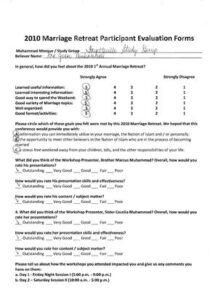Ever wonder how your recent workshop, conference, or community gathering truly landed with your attendees? Getting their honest feedback isn’t just a nice-to-have; it’s absolutely crucial for improving future events and ensuring you’re hitting the mark. Without a clear picture of what worked well and what could be better, you’re essentially flying blind. That’s where a well-crafted general event feedback survey template comes in handy.
Imagine having a structured way to gather insights on everything from the venue and speakers to the content and overall experience. It allows you to pinpoint areas of success to replicate and identify pain points that need addressing. Think of it as a compass guiding you towards even more successful and engaging events down the road. Let’s dive into what makes an effective feedback survey and how you can tailor one for your needs.
The Anatomy of an Effective Event Feedback Survey
Designing a feedback survey isn’t just about throwing a few questions together. To truly gather actionable insights, you need a thoughtful approach that covers all the key aspects of your event. The goal is to make it easy for attendees to provide valuable information without feeling overwhelmed, ensuring a higher completion rate and more useful data.
Start with broad questions and then drill down into specifics. For instance, you might begin by asking about the overall satisfaction before moving into detailed sections about various elements. This flow helps participants structure their thoughts and provides a comprehensive overview of their experience.
Consider the timing of your survey as well. Sending it out immediately after the event, while the experience is still fresh in attendees’ minds, often yields the most accurate and detailed responses. However, for multi-day events or those with post-event engagement, a follow-up survey a few days later might also be beneficial.
Key Sections to Include in Your Template
A robust general event feedback survey template should cover several crucial areas. These sections help you collect a holistic view of the attendee experience, making it easier to identify strengths and weaknesses. Here are some essential components:
- Overall Satisfaction: Simple rating questions about the event as a whole. This gives you a quick barometer of success.
- Content and Speakers: Questions about the relevance, quality, and engagement of presentations or workshop topics. Ask about specific speakers if applicable.
- Venue and Logistics: Inquiries about the location, accessibility, comfort, registration process, and any technical aspects.
- Networking Opportunities: How well did the event facilitate connections among attendees?
- Value for Time and Money: Did attendees feel the event was a worthwhile investment of their resources?
- Open-Ended Feedback: Always include a section for general comments or suggestions. This is where participants can share insights you might not have thought to ask about.
- Demographics (Optional): Basic information like industry or role can help segment feedback, but keep this minimal to avoid survey fatigue.
By including these sections, you’re ensuring that you capture a wide range of opinions and data points crucial for future planning.
Practical Tips for Maximizing Survey Response and Quality
Collecting feedback is one thing; getting enough high-quality responses to make informed decisions is another. It requires a bit of strategy and a focus on the user experience. Making the survey process as smooth and appealing as possible will significantly boost your completion rates and the richness of the data you receive.
First and foremost, keep your survey concise. While it’s tempting to ask everything, a lengthy survey can quickly lead to abandonment. Prioritize the most critical questions and consider breaking very long surveys into multiple parts if necessary, though for a general event feedback survey template, brevity is usually best. Aim for a survey that can be completed in under 5-10 minutes.
Promote your survey actively. Don’t just send one email and hope for the best. Announce it at the close of the event, include a link in follow-up emails, post it on your event’s social media channels, and perhaps even have QR codes available at the venue. The more visible and accessible it is, the more likely people are to participate.
Consider offering an incentive. Even a small incentive, like entry into a prize draw for gift cards, a discount on future events, or exclusive content, can significantly increase participation. People are more likely to dedicate their time if they feel there’s a tangible benefit for them.
Finally, act on the feedback you receive. There’s nothing more disheartening for an attendee than providing thoughtful feedback only for it to disappear into a void. Close the loop by acknowledging the feedback, perhaps by sharing a summary of the results or outlining how you plan to implement changes based on the input. This demonstrates that you value their opinions and encourages them to participate in future surveys. It builds trust and shows your commitment to continuous improvement, turning valuable insights into actionable strategies for your next successful gathering.
Gathering feedback is an ongoing process that refines your approach to event planning and execution. It’s about building a cycle of listening, learning, and improving, ensuring that each event you host is better than the last. The insights gained from a well-structured survey can illuminate pathways to greater attendee satisfaction and more impactful outcomes.
By consistently implementing and refining your feedback mechanisms, you’re not just collecting data; you’re cultivating a reputation for excellence and attentiveness to your audience’s needs. This proactive stance ensures that your events continue to resonate, engage, and deliver exceptional value, paving the way for sustained success in your future endeavors.



